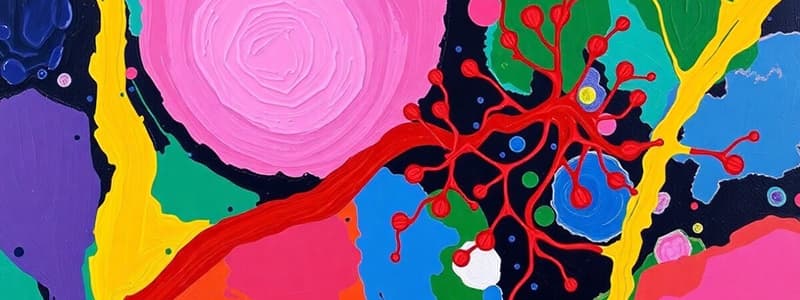Podcast
Questions and Answers
What role do Toll-Like Receptors (TLRs) play in the immune system?
What role do Toll-Like Receptors (TLRs) play in the immune system?
- They initiate innate immune responses. (correct)
- They solely recognize DAMPs.
- They directly kill pathogens.
- They promote the generation of antibodies.
Which of the following statements about the Complement system is true?
Which of the following statements about the Complement system is true?
- All complement proteins are membrane-bound.
- Complement activation can trigger a cascade of enzymatic reactions. (correct)
- Complement proteins are only involved in phagocytosis.
- Complement solely relies on antibody activation.
What triggers the Classical Pathway of complement activation?
What triggers the Classical Pathway of complement activation?
- Microbial surface structures.
- Pro-inflammatory cytokines.
- Viral RNA presence.
- Antibody-antigen complexes. (correct)
Which immune response is NOT a consequence of Pattern Recognition Receptors (PRRs) detecting PAMPs?
Which immune response is NOT a consequence of Pattern Recognition Receptors (PRRs) detecting PAMPs?
What are DAMPs and how do they contribute to the immune response?
What are DAMPs and how do they contribute to the immune response?
What is the primary function of the Alternative Pathway of complement activation?
What is the primary function of the Alternative Pathway of complement activation?
Which of the following best describes opsonization in the context of the complement system?
Which of the following best describes opsonization in the context of the complement system?
Which of the following best describes the cascade of activation in the complement system?
Which of the following best describes the cascade of activation in the complement system?
What triggers the lectin pathway of complement activation?
What triggers the lectin pathway of complement activation?
What is the role of C3a and C5a in the immune system?
What is the role of C3a and C5a in the immune system?
What effect does C3b have during the immune response?
What effect does C3b have during the immune response?
What is the primary function of the membrane attack complex (MAC)?
What is the primary function of the membrane attack complex (MAC)?
Which of the following is a characteristic of cytokines?
Which of the following is a characteristic of cytokines?
What type of interactions can cytokines have within the immune system?
What type of interactions can cytokines have within the immune system?
Which cytokines are classified as pro-inflammatory?
Which cytokines are classified as pro-inflammatory?
What does the term 'pleiotropic' refer to in relation to cytokines?
What does the term 'pleiotropic' refer to in relation to cytokines?
What role does IL-6 play in the immune response?
What role does IL-6 play in the immune response?
Which cytokine is mainly responsible for promoting Th1 polarization of helper T cells?
Which cytokine is mainly responsible for promoting Th1 polarization of helper T cells?
What function does TGF-β serve in the immune system?
What function does TGF-β serve in the immune system?
Which cytokine is primarily produced in response to viral infection?
Which cytokine is primarily produced in response to viral infection?
What is the main function of IL-2 in the immune response?
What is the main function of IL-2 in the immune response?
Which cytokine inhibits the production of pro-inflammatory cytokines by dendritic cells?
Which cytokine inhibits the production of pro-inflammatory cytokines by dendritic cells?
What does IL-4 promote in the immune system?
What does IL-4 promote in the immune system?
What is a primary characteristic of inflammation?
What is a primary characteristic of inflammation?
Which of the following is NOT a cardinal sign of inflammation?
Which of the following is NOT a cardinal sign of inflammation?
What is the primary role of vasodilation during inflammation?
What is the primary role of vasodilation during inflammation?
Which type of immune cell is typically recruited first during the inflammatory response?
Which type of immune cell is typically recruited first during the inflammatory response?
The process of leukocyte exiting the blood vessels is known as:
The process of leukocyte exiting the blood vessels is known as:
In the inflammatory response, what is an effect of increased vascular permeability?
In the inflammatory response, what is an effect of increased vascular permeability?
What signal induces the expression of E-selectin on endothelial cells during inflammation?
What signal induces the expression of E-selectin on endothelial cells during inflammation?
Which chemokine is primarily responsible for directing neutrophil migration during inflammation?
Which chemokine is primarily responsible for directing neutrophil migration during inflammation?
Recruitment of which immune cell type occurs last in the series during the inflammatory response?
Recruitment of which immune cell type occurs last in the series during the inflammatory response?
What is the primary role of CCL2 and CCL7 in inflammation?
What is the primary role of CCL2 and CCL7 in inflammation?
Which of the following is NOT a prominent systemic manifestation of inflammation?
Which of the following is NOT a prominent systemic manifestation of inflammation?
What is a major change observed during the acute phase response in inflammation?
What is a major change observed during the acute phase response in inflammation?
Which cytokines are considered the 'master cytokines' influencing inflammation?
Which cytokines are considered the 'master cytokines' influencing inflammation?
Which condition is termed the systemic inflammatory response?
Which condition is termed the systemic inflammatory response?
What is the impact of chemical mediators on vasodilation?
What is the impact of chemical mediators on vasodilation?
How does local injury affect the systemic response?
How does local injury affect the systemic response?
What common treatment targets the effects of inflammation?
What common treatment targets the effects of inflammation?
Flashcards are hidden until you start studying
Study Notes
Toll-Like Receptors (TLRs)
- Detect Pathogen-Associated Molecular Patterns (PAMPs)
- Found on the surface of cells of the innate immune system
- Crucial for detecting microbial infections
Pattern Recognition Receptors (PRRs)
- Recognize PAMPs and Damage-Associated Molecular Patterns (DAMPs)
- Activate innate immune responses:
- Aid phagocytosis
- Activate innate cells
- Promote inflammatory mediators
Danger Associated Molecular Patterns (DAMPs)
- Host proteins released during cell injury
- Activate the immune system
Complement
- A collection of soluble proteins that activate upon injury.
- Aids the immune system by:
- Promoting phagocytosis through opsonisation.
- Induce inflammatory responses.
- Directly kill pathogens.
Activation of Complement
- Activation of one component triggers an enzyme cascade.
Overview of Complement Pathways
- Classical Pathway: Triggered by the presence of an antibody-antigen complex
- Alternative Pathway: Triggered by microbial surface structures e.g. LPS
- Lectin Pathway: Triggered by mannose residues on pathogen glycoproteins binding to host lectins
- Common Feature: Activation of C3 convertase which converts C3 into C3a and C3b
Complement: Inflammation
- C3a and C5a are powerful anaphylatoxins
- Cause mast cell degranulation
- Promote vasodilation and increase vascular permeability
- C5a is chemotactic factor
Complement: Opsonisation
- C3b attaches to the outside of the microbe
- Is recognised by complement receptor 1 (CR1) on phagocytes
- Promotes phagocytosis and destruction of the pathogen
Complement: Membrane Attack Complex (MAC)
- C5b triggers the formation of MAC (C5b6789)
- Causes lysis of bacterial, virus-infected, or tumour cells
- Contains multiple copies of C9
Soluble Mediators: Cytokines
- Soluble proteins produced by a variety of cell types.
- Critical for innate and adaptive immune responses.
- Their expression can be perturbed in immune, inflammatory, and infectious disease states.
- Actions can be autocrine, paracrine, or endocrine.
- Include proinflammatory (e.g., IL-1, IL-6, TNF-α, IFNγ), anti-inflammatory (e.g., TGF-β, IL-10), and involved in cell growth and differentiation (e.g., colony-stimulating factors (CSFs) and stem cell factor).
Cytokine Properties
- Pleiotropic: Having more than one effect
- Redundancy: Several cytokines can have the same effect
- Synergy: The effect of two cytokines may be greater than the sum of each effect
- Antagonism: One cytokine may inhibit the response to another cytokine
- Cytokine Networks: Cytokines enhance or suppress the production of others generating complex cytokine networks.
Cytokine Examples
- Produced by macrophages/dendritic cells upon stimulation:
- TNF, IL-1: Induce inflammation, by acting on the endothelial cell
- IL-6: Induced acute phase proteins from the liver, promotes adaptive immune responses
- IL-12: Promotes IFN-γ production and Th1 polarisation of helper T cells. Stimulates NK cell activity
- IL-23 Promotes survival and function of Th17 cells
- Produced in response to virus:
- Type 1 Interferon (IFN-α, β) Inhibits viral replication, promotes MHC class I expression and cytotoxic T cells.
- Produced by helper T cells:
- IL-2: Clonal expansion of antigen-stimulated T cells, maintenance of regulatory T cells (Treg)
- IFN-γ: Product of Th1 cells (and NK cells), promotes activation of macrophage to be better killers of intracellular bacteria, increased MHC class I expression
- IL-4: Th2 cytokine, includes class switching to IgE
- IL-5: Activates eosinophils
- IL-17: Th17 cytokine, promotes neutrophil-based inflammation in defense against extracellular pathogens
Anti-inflammatory Cytokines
- IL-10 inhibits the production of pro-inflammatory cytokine by dendritic cells; produced by Treg, DC, and macrophages (later response)
- TGF-β: Promotes differentiation to Treg, inhibitor effector T cell function; produced by Treg and other cells. Can promote wound healing (if chronic fibrosis). But, in the presence of inflammatory cytokines, can promote Th17.
Inflammation
- Non-specific, localized, protective tissue response to injury (e.g., infection, trauma, heat).
- Intended to eliminate or wall off the cause of injury, necrotic cells, and promote tissue repair.
- Denotes by suffix “-itis”
Cardinal Signs of Inflammation
- Redness
- Heat
- Swelling
- Pain
- Functional Impairment
Steps in Inflammation
- Detection of pathogens or danger: (PAMPs, DAMPs) by innate cells results in the release of mediators that cause vascular and cellular responses
- Vasodilation and increased vascular permeability:
- Recruitment of additional immune cells: (neutrophils, then monocytes, then lymphocytes)
- Elimination of trigger:
- Resolution:
Inflammation: Vascular Changes
- Vasodilation: Increases blood flow (red, warm)
- Increased permeability: Leads to exudation of protein-rich fluid (swelling)
- Reduced blood velocity:
- Accumulation of immune cells:
Recruitment of Effector Cells
- Recruitment of effector cells to the site of infection is an important step in controlling infection.
Steps in Cell Recruitment
- Time: Neutrophils < Monocytes < Lymphocytes
Neutrophil Recruitment: Rolling
- Neutrophils are often the first cell recruited.
- Activation by inflammatory cytokines (e.g., TNFα, IL-1) induces expression of E-selectin on the endothelium.
- Weak interactions with carbohydrate ligands on the neutrophils, slows movement, causing rolling.
Neutrophil Recruitment: Adhesion
- Chemokines induce conformation changes in integrins (e.g., LFA-1), allowing the leukocyte to adhere tightly to the endothelial cells via interactions with their ligands (e.g., ICAM-1, also upregulated by inflammatory cytokines like TNF).
- Cells cross the blood vessel walls (extravasation).
- The chemokine CXCL8 (aka IL-8) directs the migration of neutrophils along its concentration gradient.
Monocyte Recruitment
- Monocytes are typically recruited (hours) later than neutrophils.
- CCL2 and CCL7 both bind to CCR2 chemokine receptor and recruit monocytes.
Inflammation Systemic Effects
- Ideally, the inflammatory response remains confined to a localised area.
- Local injury can result in prominent systemic manifestations as inflammatory mediators are released into the circulation.
- Acute phase response: A group of physiologic processes occurring soon after the onset of inflammation. The most prominent change is a dramatic increase of acute phase proteins in the serum.
- Alterations in white blood cell count: (leukocytosis or leukopenia)
- Fever:
- Sepsis and septic shock: (systemic inflammatory response syndrome) Represents the severe systemic manifestations of inflammation.
Inflammation: Chemical Mediators
- Chemical mediators of inflammation impact:
- Vasodilation
- Vascular permeability
- Chemotaxis
- Fever
- Pain
- Tissue Damage
- Often the target of anti-inflammatory drugs.
Systemic Effects of Inflammation
- IL-1 and TNF are considered the “master cytokines”
Studying That Suits You
Use AI to generate personalized quizzes and flashcards to suit your learning preferences.



